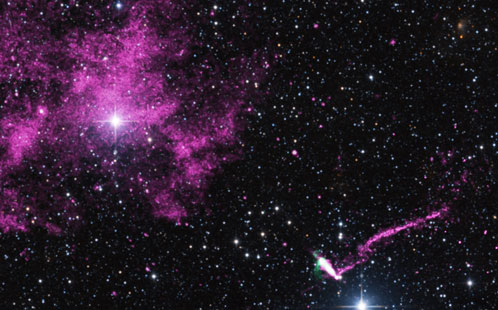
Thanks to a wide international collaboration and the use of several world class facilities an international team of scientists from the University of Western Sydney and University of Geneva-ISDC, have discovered a system hosting a very peculiar X-ray jet, the longest in our Galaxy.
A pulsar is escaping supersonically from its celestial birthplace while spewing out a record-breaking jet of high-energy particles, according to new results using NASA's Chandra X-ray Observatory. The origin of this peculiar behaviour can likely be traced back to the pulsar's birth in the collapse and subsequent explosion of a massive star.
Astrophysical jets are commonly observed in association with accretion of material onto a star, a pulsar or black hole. However, an object of this discovery is instead an isolated pulsar that is not accreting material on its surface. A pulsar is the remaining core after the explosion of a massive star, an event called supernova.
The pulsar – a type of neutron star – was originally discovered with the ESA satellite INTEGRAL, and is known as IGR J11014-6103. It is located about 60 light years away from the centre of the supernova remnant SNR MSH 11-61A.
Associate Professor Miroslav Filipovic, from the UWS School of Computing, Engineering and Mathematics, says the team was able to perform a large follow-up campaign with the NASA X-ray satellite Chandra and the Australian CSIRO radio telescopes array ATCA, which brought to unveiling the extreme properties of this system, while reading the radio observations.
"I have to say that I was very sceptical about the nature of this source when our Swiss colleagues initially contacted us. We have never seen anything like this before, and naturally we began thinking about other alternative explanations. However, after looking into our radio images the UWS team did see extraordinary things - the Universe never stops surprising us."
The IGR J11014-6103 is the first case where a jet could be identified in association with a fast runaway pulsar. This pulsar has been ejected from its birthplace during the supernova that created the entire system 10-20 thousand years ago and it's travelling since then at a velocity of 1000-2000 kilometres across the interstellar medium – a record for Galactic pulsars (for comparison the mean velocity of Galactic pulsars is 400-500 kilometres).
The jet is the longest X-ray jet known in the Milky Way galaxy. In addition to its impressive span, the jet in IGR J11014-6103 has other intriguing characteristics. For example, there is a distinct corkscrew pattern in the jet. This suggests the pulsar is wobbling like a spinning top.
The new Chandra data show that the long jet and the pulsar wind nebula – which is also seen in radio waves by the Australian Telescope Compact Array – are almost perpendicular to one another. The UWS team remotely observed this object using their Super Computer at the UWS Penrith Observatory, located in Western Sydney.
Usually, the spin axis and jets of a pulsar point in the same direction as they are moving. In this case, the spin axis of the pulsar and the direction of motion are almost at right angles to one another.
During its rush, it ejects a wind of particles (known as a pulsar wind nebula) that assumes the shape similar to a comet because of the neutron star velocity, and the long jet discovered by the team. Current theories have difficulties explaining how a pulsar can be ejected at these speeds, and at the same time produce a jet almost perpendicular to it. The shape of the winds and jet formed by the pulsar, suggest the system was formed through a peculiar core collapse event of a massive star, alternative to the core collapse mechanisms proposed up to now.
"Researchers must now begin asking the questions that this object opened on the pulsar and jet formation - what are other alternatives on the pulsar and jet formations that could account for the formation of system such as this one? The presence of its close-by, bright, supernova remnant provides also the opportunity to study the core collapse supernova mechanisms that formed the IGR J11014-6013."
"Widening our understanding of these phenomena has potential implications on several aspects of astrophysics, where supernovae have a major role: from star evolution up to neutron stars and black holes' distribution properties, as well as to cosmological implications," says Associate Professor Filipovic.
The supernova remnant that gave birth to IGR J11014-6013 is elongated along the top-right to bottom-left direction, roughly in line with the jet's direction. These features and the high speed of the neutron star are hints that jets could have been an important feature of the supernova explosion that formed IGR J11014-6013.
Ends
19 February 2014


